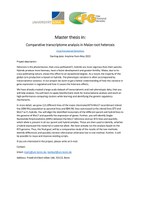Master thesis: Comparative transcriptome analysis in Maize root heterosis
Heterosis is the phenomenon, that cross-pollinated F1-hybrids are more vigorous than their parents. Hybrids produce more biomass, have a faster development and greater fertility. Maize, due to its cross-pollinating nature, shows this effect to an exceptional degree. As a result, the majority of the global corn production is based on hybrids. The phenotypic variation is often accompanied by transcriptomic variance. In our project we want to get a better understanding of how this variance in gene expression is regulated and how it causes the heterosis effects.
![]() MA_Maize_Transcriptome.pdf
— 604.5 KB
MA_Maize_Transcriptome.pdf
— 604.5 KB

